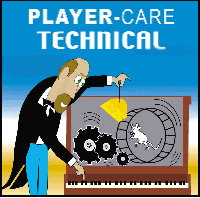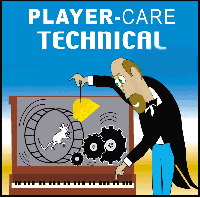
|

|

|

|

|

|
| Home | Manuals | Supplies | Search | Consult | Contact | Testing | Service |


Modern Aeolian |
|
The following is my reply to a question submitted by a visitor to Player-Care Since Aeolian used the same basic configuration on all of it's foot pumped/electrically driven units, the information has been turned into this webpage. For the 55 page Service Manual about the Standard Pneumatic Action used in the entire line of modern Aeolian player pianos (both 64-note and 88-note types) -- Click Here Player-Care now sells the Aeolian-Type Plastic Block Valves - Click Here for More Information. HI Rex, You are obviously referring to the modern Aeolian console and spinet players, made from around 1961 through 1986. Your questions, and the answers which follow will make a good addition to the database of information I've been compiling on the modern Aeolian players. 1. How do you remove the player stack from these pianos to service the action when the tracker bar is mounted above the keybed and the pneumatics are below the keybed? ANS. You don't! First, remove the air motor, bass and treble soft devices and the soft pedal rod. Then loosen the leather nut/s on the manual sustain linkage and disengage the sustain pedal rod from the piano action (don't try to remove the rod from the piano). Next, disconnect the tempo control linkage on the far lefthand side of the player action. It's a little hard to access the leather nut since it's down in the space directly behind the left cheek block. Remove the honky-tonk rail if present. Disconnect the vacuum supply hose at the air motor governor. Now, locate and remove the four screws that hold the upper platform in place (on the extreme right and left hand edges of the platform). Locate and remove the support brackets holding the spoolbox to the piano. Locate and remove the two cap nuts on the platform. Not all Aeolian products have the cap nuts, which are located in front of the spoolbox, just to the right and left of the box. Depending on the model, it is also advisable to disconnect the stack cut-out tube at the cut-out valve and any remaining vacuum supply tubes leading to the tracker device and/or reroll device. Now, all that's left connecting the upper and lower portions of the player assembly are the note tubes. Leave them alone! Take a thick movers blanket and place it over the keys, cheek blocks and arms of the piano. (I fold the blanket in fourths and lay it lengthwise across the whole front of the instrument. This is done to avoid scratching the piano.) Next, lift the upper portion of the player mechanism up an inch or so and move it towards the front of the piano. It will usually move about six inches. Be careful not to drag the underside of the platform on the two support rods to which the cap nuts were connected. There are tubes running under the platform that can be easily damaged. Also, (in some models) there is a flap-type valve mounted on the underside. With patience and persistence, you can move the whole assembly far enough towards the front of the piano to get to the action. But you're not done yet! Next, remove the piano action frame nuts and any screws holding the action frame to the piano. Also, if present, remove the small wooden blocks on the inside sides of the piano to which the front board/music rack is connected. Now the action is ready to be removed from the piano. And at this point, you have a choice to make. You can either ask for assistance from the customer or make a support rod to keep the player action from falling backwards while you remove the piano action. I prefer asking for help. It makes the customer feel needed and most are happy to help. If not, have a piece of 1/2" doweling on hand and cut it down to size, and place it between the uppermost part of the plate and the uppermost part of the spoolbox, giving yourself as much room as possible. Now, gently remove the piano action. Naturally, to install the action and upper player portion, reverse this procedure. But remember to attach the sustain rod to the sustain lever after putting the piano action back in the piano. 2. Can you let me know where I can get technical information on the regulation and repair of these player actions? ANS. I sell the 55 page Service Manual, which covers the general testing and regulating of all the modern Aeolian players. (88-note and 64-note Standard Pneumatic Action). The cost is $15.00 for the PDF file. Send check to:
John A. Tuttle Extra note: When it becomes necessary to adjust the lost motion adjustment (piano action), I've found that it's easier to make coarse adjustments with the action out. Then once the action is back in, you won't spend so much time leaning over the player action and adjusting each capstan the full amount. There is NO easy way to adjust the capstan, and the tool I use is made from a relatively soft metal that can be bent something like this: ____/ , which makes it easier to access the capstans. You cannot watch the capstan while making the adjustment, it's all done by 'feel'. Just writing about it gives me a backache. ;-) Musically,
John A. Tuttle
At 10:48 AM 10/20/99 -0000, you wrote: I am a piano tuner and am do basic work on players when needed. A few of my customers have Aeolian players in direct blow action style pianos. There are two questions I have that I am hoping you might be able to help me with. 1. How do you remove the player stack from these pianos to service the action when the tracker bar is mounted above the keybed and the pneumatics are below the keybed? There is not enough room to remove the action with the upper assembly in, but there is not an obvious way to remove the player when the tubing is routed around the end of the keybed. 2. Can you let me know where I can get technical information on the regulation and repair of these player actions? Thank you for you time and consideration.
Rex Roseman
To purchase the 55 page Service Manual for the 64-note and 88-note Standard Pneumatic Action (used in Aeolian products) online - Click Here!
|

![]() ..To
The Top of this Page . . . . . . . . . . .
..To
The Top of this Page . . . . . . . . . . . ![]() ..To The HOME Page
..To The HOME Page
|
Since "Player-Care" is an internet business, I prefer that we correspond via E-Mail (click here to fill out the 'Request Form'). However, if I'm not in the middle of some other activity, you can reach me at 732-840-8787. But please understand that during the hours from 8AM-5PM EST (Mon-Sat), I'm generally quite busy. So, I probably won't answer the phone. If you get the answering machine, please leave a detailed message stating the reason for your call. Also, repeat your name and phone number clearly and distinctly. By necessity, I prioritize everything in my life. And, if you call and just leave your name and number, and ask me to call you back, it might be a day or two before I return your call. Why? Because I don't know why you want me to call and I might not be prepared to assist you in an effective and efficient manner. If you leave me an E-Mail address (which I prefer), spell it out phonetically. The more you do to help me, the more I can help you in return. Don't rush. You have four minutes to record your message. |
|
407 19th Ave, Brick, NJ, 08724 Phone Number 732-840-8787 (Voicemail Only, No Texts) |
